Newport News Shipbuilding and Dry Dock Co.
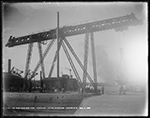 | 503k | This is a photograph of the crane Hercules lifting a Plunger class submarine, looking Northwest, 11/2/1905. | Photo courtesy of NARA, Record Group 181: Records of Naval Districts and Shore Establishments, 1784 - 2000.
Photographs of the Construction and Repair of Buildings, Facilities, and Vessels at the New York Navy Yard, 1903 - 1920.
|
 |
846k |
Four of our submarines in dry dock in government navy yard. |
Photo courtesy of Tommy Trampp.
|
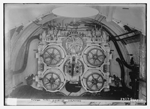 | 565k | Torpedo Tubes, American Submarine, circa 1910-15. | LOC photo # LC-B2-3437-11 / 18818v from Bain News Service, courtesy of lcweb2.loc.gov. |
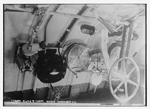 |
604k |
Diving wheel & depth charges of a B or C boat, circa 1910 - 1915.
OK, here is what I think. In the photo you have is a wire mesh screen that is seen on the right hand side of the photo. It has a reinforcing bar across it.
Compare this with the interior photo I have in the C-1. It doesn't show the dive station but it does show a port side wire mesh cage with the same features. I'm 95%+ sure this is a dive station on a C-Class submarine.
|
USN photo # LC-B2-3437-15a, from the George Grantham Bain Collection, courtesy of the Library of Congress, from the National Museum of the U.S. Navy, courtesy of flickr.com.
Photo i.d. & text courtesy of Ric Hedman.
|
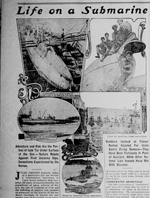
0836042 |
NR |
LAUNCHING OF SUBMARINE NARWHAL (D-1) (SS-17)
FISH NAME8 DROPPED
.....This can now apply to the diving vessels of the American navy. No more fish names are to be given to the submarines. The practice instituted by Charles Bonaparte while secretary of the navy is now held to be confusing and useless. As rapidly as possible the picturesque names hitherto used by all these little fighting craft are being painted out and numbers and letters being substituted in their stead.
|
Image and text provided by South Dakota State Historical Society – State Archives.
Photo from Pierre Weekly Free Press. (Pierre, S.D.) 1889-19??, 14 March 1912, Image 6, via chroniclingamerica.loc.gov.
|
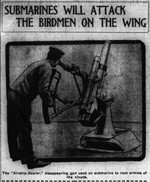 |
1.06k |
SUBMARINES WILL ATTACK THE BIRDMEN ON THE WING |
Image and text provided by University of Hawaii at Manoa; Honolulu, HI.
Photo from Honolulu Star-Bulletin. (Honolulu [Oahu, Hawaii) 1912-current, 21 June 1913, 3:30 Edition, Image 1, courtesy of chroniclingamerica.loc.gov. |
 |
60k |
Severn with one C-class boat alongside, circa 1913-1916, probably at Panama.
|
Photo courtesy of Ric Hedman. |
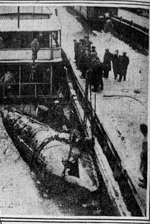 |
537k |
OLD SUBMARINE RAISED AFTER 20 YEARS
This was one of the first underwater craft attempted in this country. On a trial trip it dived and failed to come up again. It has just been lifted from the bed of the river at Chicago after two unsuccessful attempts. It is 30 feet-long and-five feet wide. It was named "Fool Killer No. 1."
It's inventor was Lodner Darvontis Phillips. |
Link inset courtesy of Ric Hedman.
Image and text provided by Penn State University Libraries; University Park, PA.
Photo from Evening Public Ledger. (Philadelphia [Pa.]) 1914-1942, 29 December 1915, Night Extra, Image 16, via chroniclingamerica.loc.gov.
|
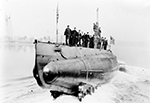 | 224k | Bow view of the launch of somebody!
I think this is an H-Boat. It had a bullnose that the D's didn't have and chain/cable fairleads on the deck edge like the H have. Looking closer still there is a chance it could be a K class also.
| Photo & text i.d. courtesy of Ric Hedman.
Photo # N1295 by Warren S. Parker, courtesy of the Boston Public Library, Leslie Jones Collection via flickr.com.
|
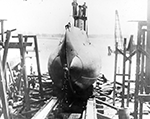 | 292k | Views from what I think is Fore River: View of the launch of somebody to the sea. | USN photo # LS1034 by Warren S. Parker, courtesy of the Boston Public Library, Leslie Jones Collection via flickr.com.
|
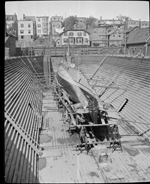 |
467k |
Your local neighborhood submarine, most likely an unidentifiable K-class, circa 1916. |
Photo i.d. courtesy of David Johnston (USN, retired) with input from Ric Hedman.
Photo courtesy of the Boston Public Library, Leslie Jones Collection via Sean Hert & flickr.com. |
 |
729k |
FLEET OF U.S. SUBMARINES ON THEIR WAY TO SEA |
Image and text provided by The New York Public Library, Astor, Lenox and Tilden Foundation.
Photo from The Evening World.
(New York, N.Y.) 1887-1931, 05 February 1917, Final Edition, Image 3, via chroniclingamerica.loc.gov. |
 | 2.21k | This picture shows the sort of target a U-boat presents to American gunners, although in this picture the periscope of an American submarine is seen, circa 1917-18. | National Archives Identifier: 45513814
Local Identifier: 165-WW-338B-060
Photo courtesy of catalog.archives.gov
|
 |
427k |
SUBMARINE, ONE OF THE BATTLE FLEETS operated over the Chicago & North Shore & Milwaukee Railroads of Chicago, in the interest of Navy recruiting and later in the interest of the former Liberty Loan drives. This fleet later "cruised" over the electric lines of Illinois and other states of this naval district, circa 1917-18. |
National Archives Identifier: 86712473
Local Identifier: 111-SC-53635
Photo courtesy of catalog.archives.gov |

0836001a |
1.93k |
Lantern Slide of the Interior of the Submarine |
Meyer Silverman Collection, ca. 1900 - 1963
Series:Lantern Slides of Navy Vessels and the Fifth Marine Regiment in France during World War I, ca. 1917 - ca. 1963
National Archives Identifier: 178140430
Local Identifier: DM-SILVR-M-81a-7
Photo courtesy of catalog.archives.gov |
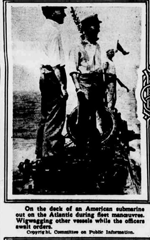 |
430k |
On the deck of an American submarine out on the Atlantic during fleet manoeuvres. Wigwagging orders. | Image and text provided by The New York Public Library, Astor, Lenox and Tilden Foundation.
Photo & text by The Sun. (New York [N.Y.]) 1916-1920, 28 April 1918, Section 4 Pictorial Magazine, Image 41, via chroniclingamerica.loc.gov. |
 | 132k | Navy Dirigible convoying a U.S. submarine cruising "Somewhere in the Atlantic.", May 1918. | Photographer: International Film Service
National Archives Identifier: 20807816
Local Identifier: 165-WW-63D-5.
Photo courtesy of catalog.archives.gov
|

08360x17 |
NR |
Aboard an American Submarine in the War Zone -
WITH AN AMERICAN SUBMARINE FLOTILLA, at an European Base. |
Image and text provided by Library of Congress, Washington, DC.
Photo & text by Evening Star [volume] (Washington, D.C.) 1854-1972, 04 August 1918, Image 35 & 50, courtesy of chroniclingamerica.loc.gov.
|
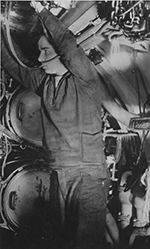 | 375k | Listening for enemy submarines in an American undersea boat. | National Archives Identifier: 45511640
Local Identifier: 165-WW-329C-018
Photo courtesy of catalog.archives.gov
|
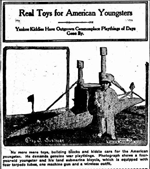 |
1.99k |
Real Toys for American Youngsters
Yankee Kiddies Have Outgrown Commonplace Playthings of Days Gone By.
No more mere toys, building blocks and kiddie cars for the American youngster. He demands genuine war playthings. Photograph shows a four year-old youngster and his land submarine bicycle, which is equipped with four torpedo tubes, one machine gun and a wireless outfit. |
Image provided by: Minnesota Historical Society; Saint Paul, MN.
Photo from The Tomahawk.
(White Earth, Becker County, Minn.) 1903-192, 19 December 1918, Image 4, via chroniclingamerica.loc.gov. |
 | 211k | Sleeping Quarters in American Submarine. American Sailors asleep in narrow aboard American Submarine, October 1918. | National Archives Identifier: 45512040
Local Identifier: 165-WW-332A-002.
Photo courtesy of catalog.archives.gov
|
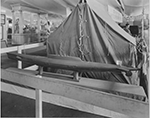 | 1.03k | Council of National Defense - Connecticut State Council of Defense War Exhibit, Hartford, Connecticut. Model of submarines. | National Archives Identifier: 26432865
Local Identifier: 165-WW-135A-53.
Photo courtesy of catalog.archives.gov
|
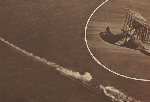 | 627k | "A submerged American submarine firing a torpedo as seen from a U.S. Navy seaplane at an elevation of 1,000 feet.
The compressed air from the torpedo tube has just risen to the surface where it has the appearance of a cloud of steam. The wake of the U-boat's periscope also appears plainly."
The identity of this sub was not listed.
INSERT:- A photographer perched on the nose of a naval seaplane, as seen from another machine flying obliquely above. The camera man's position, far in advance of the pilot, gives him an extraordinary range of vision in three directions." |
Photo & text courtesy of N.Y. Times, 9 March 1919, Page 2, courtesy of memory.loc.gov.
|
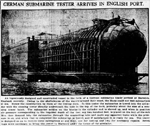
08360tester |
NR |
GERMAN SUBMARINE TESTER ARRIVES IN ENGLISH PORT.
An ingeniously designed and constructed vessel in the form of a German submarine tester arrived at Harwich,England, recently. Owing to the shallowness of the waters around their coast, the Huns could not test submarines at sea. Hence the construction by them of the testing dock. In this tester the submarine is towed into the cylinder with the conning tower directly underneath the hole in the top of the dock, probably about the size of a conning tower hatch. The submarine settles on the blocks in the cylinder and is shoved up, and when in position air pressure corresponding to the required depth of the test, say, two hundred feet, is placed on the hull of the submarine. Men then descend into the submarine through the connecting tube and caulk any apparent leaks while the pressure is on, and when that is completed the submarine is tested, and if satisfactory' it is ready for sea. The tester is designed so as to receive three submarines at one time, one for testing and two for necessary repairs. Seven tugs were necessary to bring the tester to Harwich under the terms of the armistice. |
Image and text provided by Library of Congress, Washington, DC.
Photo & text by Evening Star [volume] (Washington, D.C.) 1854-1972, 20 July 1919, Image 4 courtesy of chroniclingamerica.loc.gov.
|
 |
842k |
Pacific Entrance to Panama Canal Showing US Submarines, c1920s. |
Photo by The Print Collector/Print Collector/Getty Images) courtesy of gettyimages.com. |
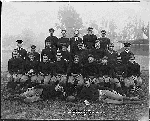 | 122k | "Football team, USN Submarine Division #16, US Navy Yard, Mare Island,CA.", ca. 1924 | National Archives Identifier: 296878
Photo courtesy of catalog.archives.gov
|
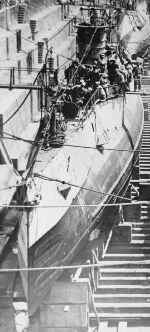 |
40k |
What was thought to be the S-15 (SS-120) in Dry Dock circa 1925, possibly Mare Island Shipyard since the boats near her in the dry dock were all reported to be at Mare Island at that time too.
There is no doubt at all that this is an EB design 20 series S-boat Which one is uncertain, but it definitely is NOT the S-15 |
Photo & text courtesy of Ric Hedman.
Photo i.d. courtesy of David Johnston |
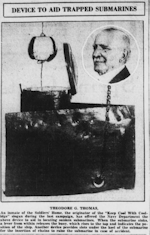 |
NR |
Device to aid trapped Submarines
THEODORE G. THOMAS.
An inmate of the Soldiers' Home, the originator of the "Keep Cool With Coolidge" slogan during the last campaign, has offered the Navy Department the above device to aid in locating sunken submarines. When the submarine sinks, a lever from within releases the buoy, which rises to the top and indicates the position of the ship. Another device provides slots under the keel of the submarine for the insertion of chains to raise the submarine in case of accident. |
Image and text provided by Library of Congress, Washington, DC.
Photo & text by Evening Star [volume] (Washington, D.C.) 1854-1972, 16 April 1928, Image 23, courtesy of chroniclingamerica.loc.gov. |

0815600 |
2.70k |
Two O-class submarines in port at Coco Solo, Panama, mid 1920’s. The submarine in the background has a temporary canvas and plastic windbreak installed around the forward end of the bridge.
| Text i.d. via Dave Johnston & Ric Hedmen.
Photo courtesy of Steve Hatchett. |
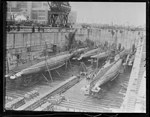 |
412k |
Submarine being overhauled, Philadelphia Navy Yard drydock, 19 March 1929.
The boats might be K-boats, with one Lake design N-class |
Photo i.d. courtesy of David Johnston (USN, retired) & Ric Hedman.
Photo 08_06_006682 courtesy of the Boston Public Library, Leslie Jones Collection via Sean Hert & flickr.com.
|
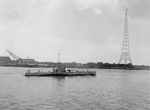 | 400k | SEA.S.I. Celluloid Investigators Case AL-17
The AL-17 probably plows the waves in a supporting cast for S-23 (SS-128) as Hollywood takes to the airwaves
The boat is without doubt a post-safety conversion (i.e. early 30's) EB S-boat It is hard to tell due to the quality of the picture, but the boat appears to have the rounded bow plane pivot fairings of the 30 series boats (S-30 to 41). The conning tower fairwater configuration rules out S-42 to 47
I have an ongoing project to research the unusual numbers that have shown up on U.S. boats in the years prior to WW1. They are vertically arranged two digit numbers that do not match the boat's hull number. So far the data I have gathered show no direct correlation between the boat's name, hull number, or squadron/flotilla assignment. These numbers seem to have disappeared when the war started, only to make a comeback in a few photos from WWII. In this case, the AL-17 designation matches the style and location of the AL-14 that we confirmed to have been part of the movie.
I am still way open for suggestions, but for right now I am leaning heavily towards these photos being related to the shooting of Hell Below |
Text & photo i.d. courtesy of David Johnston with input from Jim Christley & Ric Hedman.
Photo from the private collection of Ric Hedman. |
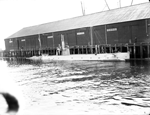 |
2.84k |
Two views of an unidentified H boat at Johnson Wharf. |
Photo i.d. courtesy of Ric Hedman.
Photos # CVA 260-80 & 260-94 courtesy of James Crookall via searcharchives.vancouver.ca courtesy of John Hummel, USN (Retired). |

080000w |
1.81 |
Many ships at inner Balboa Harbor, Panama. Likely taken 1934-1935.
The California (BB-44) is the battleship on the left, the Indianapolis (CA-35) is behind her, along with one of the Omaha class cruisers interspersed with various destroyers & other craft.
6 submarines are at the right end of picture alongside their tender Holland (AS-3).
Regarding a positive i.d. it is hard to tell. The photo seems to indicate that they are: Narwhal (SS-167), Barracuda (SS-163), Bass (SS-164), Bonita (SS-165), Dolphin (SS-169). The outer boat is Cachalot (SS-170).
It should be noted that during these large "Fleet Problem" exercises in the waters off Panama it was common for ships from both the Atlantic and Pacific fleets to co-mingle. It was one of the reasons that many of the Fleet Problem exercises were held off Panama. It allowed joint operations between the fleets and was more efficient because you didn’t have to have an exercise for each fleet.
The absence of Porpoise/Perch class subs in the photo, combined with the fact that the boats are painted black strongly indicates that this is in the 1934-35 time frame. As the new boats came on line the lineups within the squadrons changed dramatically so a document from 1939 will not be of much use in this case |
Photo i.d. courtesy of David Johnston, Ric Hedman & Richard M. Jensen.
Photo courtesy of Walter Fish via Steve Hatchett & Fabio Pena.
|
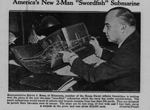
0836038s |
NR |
America’s New 2-Man Swordfish Submarine
Representative Melvin J. Maas, of Minnesota, member of the House Naval Affairs Committee, is looking over the plans of the new two-man swordfish submarine which the navy has under consideration. The small submarines would travel in schools and torpedo enemies from less than 250 yards. They are designed to permit their two-man crew to escape. The ships are 51 feet long, 10 feet wide and 7 feet high, carry a torpedo in the prow, and cost about $12,000 each. |
Central Press photo.
Image and text provided by University of North Carolina at Chapel Hill Library, Chapel Hill, NC.
Photo from Henderson Daily Dispatch. (Henderson, N.C.) 1914-1995, 16 June 1938, Image 1, via chroniclingamerica.loc.gov.
|
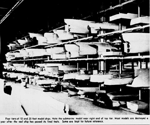
0836040d |
NR |
Four tiers of 10 ond 20 foot model ships. Note the submarine model near right end of top tier. Most models are destroyed a year after the real ship has passed its final tests. Some are kept for future reference. |
Image and text provided by Library of Congress, Washington, DC.
Photo & text by Evening Star [volume] (Washington, D.C.) 1854-1972, 01 December 1940, Image 133, courtesy of chroniclingamerica.loc.gov.
|

08360or |
NR |
Short Cruise on a U. S. Sub
This is how the bow of a submarine looks as the craft begins to submerge. There is no sensation of plunging, merely a tilting of the deck and an effort by the landlubber to adjust his balance.
View of the depth native. Indicator here points to 38 feet.
The man at the wheel controls the depth. Living accommodations are not luxurious. Here is how the sleeping quarters are arranged, in three-tier bunk.
The eye of the submarine is its periscope, a gadget something like the view-finder on an ordinary camera. Here you see a gentleman of the press taking a peek through the periscope. The whole horizon may be surveyed.
Standing inside a sub hatch the main conning tower shaft open, this is what you see. On the submarine every man
is an expert. This is a view of the engine compartment. |
Image and text provided by University of Nebraska-Lincoln Libraries, Lincoln, NE.
Photo & text by The Frontier. (O'Neill City, Holt County, Neb.) 1880-1965, 19 March 1942, Image 6, courtesy of chroniclingamerica.loc.gov. |
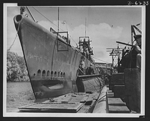 | 457k | On the shores of America's inland waterways, many underwater crafts are being constructed. This submarine is undergoing finishing touches in a small bay at Manitowoc, Wisconsin. | LOC photo # LC-USE6-D-006233 / 8b04306v from lcweb2.loc.gov. |
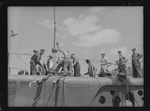 | 350k | Caption reads: Installation of an engine part in a submarine under construction at Manitowoc, Wisconsin.
The work is plainly being done on the bow (pointy end to the left) since the bow plane recess can be seen in the right foreground. Looks more to be an air flask being installed under the deck. | Text i.d. courtesy of Ric Hedman.
LOC photo # LC-USE6-D-006235 / 8b07453r from lcweb2.loc.gov. |
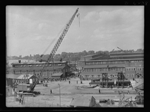 | 380k | As the shift changes, workers pour out of the shipyards at Manitowoc, Wisconsin, where submarines are built on a twenty-four-hour day, seven-day week basis. | LOC photo # LC-USE6-D-006238 / 8b07454v from lcweb2.loc.gov. |
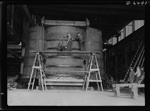 | 373k | Construction of the hull section of a submarine at Manitowoc, Wisconsin. These sections will be assembled in a small bay, and when completely installed will be sent down the Mississippi to the Panama Canal. | LOC photo # LC-USE6-D-006241 / 8b07456v from lcweb2.loc.gov. |
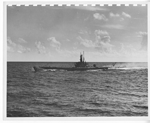 | 439k | An unidentified submarine is pictured at sea and underway. A sailor works near the stern of the submarine, circa 1942.
The derrick makes me think torpedo practice stateside or at the Canal Zone training area, for example. | The photograph is included in Lewis Parks's photo album entitled "Submarine Pictures W. War II."
Photos # 2015-78 (insert) & 77 courtesy of trumanlibrary.org.
Text i.d. courtesy of Robert Morgan.
|
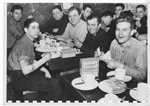 | 363k | A group of submarine sailors enjoy dessert after their noon meal. Each table seats six men and are folded out of the way when not in use providing the crew a "recreation room" onboard the submarine. | The photograph is included in Lewis Parks's photo album entitled "Submarine Pictures W. War II." The photograph is cropped off at the top.
Photo # 2015-75 courtesy of trumanlibrary.org.
|
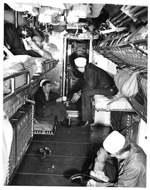 | 455k | Four unidentified sailors relax in the sleeping area of a United States Navy submarine. | The photograph is included in Lewis Parks's photo album entitled "Submarine Pictures W. War II."
Photo # 2015-54 courtesy of trumanlibrary.org.
|
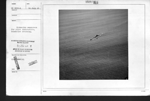 |
878k |
Submarine maneuvers for pilot instruction. Submarine crusing, 24 July 1942.
This boat is a Government design S-boat She is too long forward of the fairwater to be an EB design and the fairwater matches that of the Government boats. It could be any boat between S-11 (SS-116) and S-17 (SS-122) (those were the Government boats that served through WWII). It is not the S-48 (SS-159) as she had been extensively modified and did not look like this boat. |
Photo & text i.d. courtesy of David Johnston (USN, retired)
USN photo # 80-G-1626 from National Archives and Records Administration (NARA), College Park, Maryland, courtesy of Sean Hert.
|
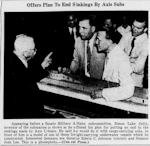 |
NR |
Offers Plan To End Sinkings By Axis Subs
Appearing before a Senate Military Affairs subcommittee, Simon Lake (left),inventor of the submarine is shown as he offered his plan for putting an end to the sinkings made by Axis U-boats. He said he would do it with cargo-carrying subs. In front of him is a model of one of these fre ight-carrying underwater vessels which he constructed. Interested listeners are Senator Edwin C. Johnson (center) and Senator
Josh Lee. This is a phonephoto. |
(Central Press Photo). Image and text provided by University of North Carolina at Chapel Hill Library, Chapel Hill, NC.
Photo & text by The Wilmington Morning Star. (Wilmington, N.C.) 1909-1990, 07 August 1942, FINAL EDITION, Image 12, courtesy of chroniclingamerica.loc.gov. |
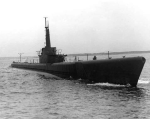 |
39k |
This photo was thought to be Steelhead (SS-280) shortly after her launching at Portsmouth Navy Yard, Portsmouth, N.H., 11 September 1942. It is in fact an early production Government Balao in a 2/1-1 configuration. |
Text & photo i.d. courtesy of David Johnston
USN photo courtesy of subvetsofwwii.org. |
 |
554k |
OLD WARRIOR JOIN THE SCRAP;"These decommissioned U.S. submarines, built between 1917 and 1921, have been towed from the Philadelphia Navy Yard up the Delaware River to be junked. They will add some 4,430 tons to the nation's depleted scrap pile."
It is possible that these subs are the S-3 (SS-107), S-6 (SS-111), S-7 (SS-112), S-8 (SS-113), S-9 (SS-114).
They were all struck from the Navy list on 25 January 1937 and subsequently scrapped, date unknown. |
Photo from the Vallejo Times Herald, Vallejo, California, 25 October 1942 courtesy of Darryl L. Baker. |
 |
1.59k |
Gato class Mod 3 (high bridge, SJ radar forward). It is hard to tell due to the angle and quality of the pic, but it looks like an EB design boat. Date is probably mid 1943. |
Photo & text i.d. courtesy of David Johnston
USN photo courtesy of Scott Koen & ussnewyork.com
|
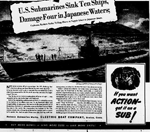 |
NR |
Head lines from New York Herald Tribune, 9 July 1943.
Victorious U. S. submarine returning to its base somewhere in the Pacific. Broom tied to periscope denotes "clean sweep"
So buy more Bonds to send more subs to sink more ships...Nelseco Submarine Works, ELECTRIC BOAT COMPANY, Groton, Conn.
|
Image and text provided by Library of Congress, Washington, DC.
Photo from Evening Star [volume] (Washington, D.C.) 1854-1972, 16 July 1943, Image 13, via chroniclingamerica.loc.gov. |
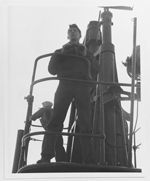
0836043a |
868k | View taken aboard an unidentified sub, off New London, Connecticut, circa August 1943, showing lookouts on watch.
Possible boats could be Dace (SS-247), Dorado (SS-248), Flasher (SS-249), Flier (SS-250), Flounder (SS-251), Gabilan (SS-252) & Capelin (SS-289). | USN photo 80-G-468334 courtesy of history.navy.mil |
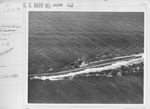 |
1.10k |
4 November 1943. The boat is beyond a doubt NOT the Flasher (SS-249), despite what the caption on the left of the photo says. This boat is a Government design 2/1/1 Balao class boat. Flasher was a EB design Mod 3 Gato (finishing the war as a Mod 4A Gato). This becomes very apparent when you compare the photo in question to other confirmed photos of the Flasher on the same page. The photographer seemed to have struggled with which boat he had photographed. The ID on the left in the photo had been scratched out a few times and re-written. He apparently forgot or got confused. |
US National Archives photo # 80-G-450235, from NARA, College Park, Maryland, courtesy of Sean Hert.
Photo i.d. courtesy of David Johnston. |
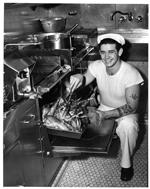 | 404k | An unidentified Navy cook smiles for the camera and displays the roasting fowls being prepared for dinner on board the submarine, circa 1943. | The photograph is included in Lewis Parks's photo album entitled "Submarine Pictures W. War II."
Photo 2015-51 courtesy of trumanlibrary.org.
|
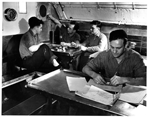 | 339k | Four unidentified submarine sailors relax while off duty on a United States Navy submarine, circa 1943. | The photograph is included in Lewis Parks's photo album entitled "Submarine Pictures W. War II."
Photo # 2015-58 courtesy of trumanlibrary.org.
|
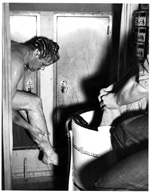 | 473k | An unidentified sailor takes a shower while another sailor washes clothes onboard a United States Navy submarine, circa 1943. | The photograph is included in Lewis Parks's photo album entitled "Submarine Pictures W. War II."
Photo # 2015-56 courtesy of trumanlibrary.org.
|
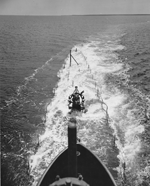 | 928k | This looks to be a 3"/50 on quite possibly a Sargo or Salmon class during training operations out of New London, Connecticut, 26 November 1943. | Photo i.d. courtesy of Ric Hedman.
USN photo # 80-G-43876 by Cdr. Edward J. Steichen, from National Archives and Records Administration (NARA), College Park, Maryland, courtesy of Sean Hert. |
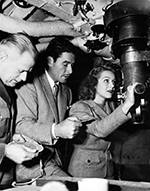 |
662k |
Naval Air Station, Dutch Harbor, 4 December 1943. Shown is Errol Flynn, with Commander McDowell and Martha Driscoll at periscope.
|
Photo # 80-G-209976 courtesy of the National Museum of the U.S. Navy, via flickr.com.
|
 | 18k | Photo of the Gar (SS-206) underway, circa 1941-45, place unknown.
The identification of this photo is suspect due to the following:
Salmon (SS-182), Seal (SS-183), and Skipjack (SS-184) all had their periscope shears extensively rebuilt during overhauls at Mare Island in the summer of 1944. They came out of these overhauls with shears that looked very much like those of the early Balao's Snapper (SS-185), Stingray (SS-186), and Sturgeon (SS-187) all received less extensive mods that put their looks somewhere between a late Gato or early Balao An example can be seen on the Salmon page.
Flying Fish (SS-229) seems to be the lone Gato class "covered wagon" boat to have her shears completely rebuilt. Why this was done is a mystery. Ric Hedman contributed a photo of the Flying Fish that clearly shows this. It doesn't quite match the Salmon mods, and isn't quite like the later Balao configuration. It seems to be a unique, one off modification that as far as I can tell wasn't applied to any other Gato
In doing this research I discovered something that had not struck me before. The Sargo was the first of the "covered wagon" boats. Starting with Sargo, the interior structure of the conning tower fairwater was beefed up with the distinctive heavy vertical frames that, once the fairwater was cut down and some of the outer plating removed during the war, gave these and subsequent boats (through the Gato's) that ribbed, covered wagon look. The Sargo's were the first boats to have 40 foot long periscopes, previous boats having 34 footers. The longer scopes tended to vibrate at higher speeds so the beefed up shears design was most likely an attempt to mitigate this problem. The top of the "covered wagon" ribs provided excellent lookout stations so there was little if any impetus to radically alter the shears and the upper fairwater.
One modification that does not seem to have been ever made on any boat that had the original fairwater design was the shortening of the fairwater under the cigarette deck, as is shown in the suspect "Gar" photo that I mentioned below. All the fleet boats prior to the late built Gato's had a watertight door built into the aft end of the conning tower cylinder. This allowed the deck gun crew access to the gun by going through this door into a void space inside the fairwater. They would then exit onto the main deck through a cutout in the fairwater that can be seen in many photos. This void space was between the aft end of the conning tower and the very large Main Air Induction Valve. This man sized valve sat vertically inside the very aft end of the fairwater. In order to cut away and shorten the fairwater, the Induction Valve would have to be moved forward. The small reduction in fairwater visibility this would have given was offset by the complexity and difficulty of moving this major valve. I have yet to see a single instance of this type of modification being performed.
The Balao's and Tench's had a redesigned conning tower that eliminated this door entirely and replaced it with a completely separate gun access trunk at the forward end of the fairwater that led into the control room directly. This allowed the designers to move the Main Air Induction Valve forward and shorten the length of the fairwater from the start, giving the Balao and Tench fairwaters a look distinct from that of the Gato's and earlier boats. | USN photo courtesy of Hyper War, US Navy in World War II.
Text & i.d. courtesy of David Johnston |
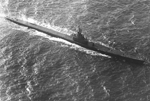 |
1.34k |
Balao class in the as-built 2/1/1 mast configuration. With the cutaway of the aft part of the fairwater under the cigarette deck and the gun configuration this dates the photo to early 1944. Once again, due to the quality and angle of the photo it is unclear if it is a Government or EB design. |
Photo & text i.d. courtesy of David Johnston
USN photo courtesy of Scott Koen & ussnewyork.com
|
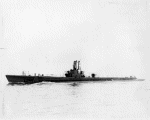 | 35k | Thought to be the Runner (SS-275), underway, with cut down bridge with the open cigarette decks probably after her arrival at Pearl Harbor.
The boat in the photo is an unknown Balao / Tench class.
| USN photo.
Partial text courtesy of John Hummel, USN (Retired).
Photo & i.d. courtesy of David Johnston |
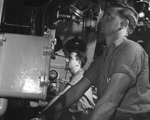 |
735k |
The photo looks to have been taken in the manoeuvring room of a sub.
The Navy caption for the photo is also attached). |
Text i.d. courtesy of Ric Hedman.
Official USN photo # NA-ST-59-43499-TR-5919, courtesy of Darryl L. Baker. |
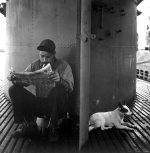 | 650k | Life beneath the seas on a U.S. submarine. A submariner reading his favorite comic-strip. The submarine mascot pants in the shade of the conning tower, circa January 1944 (maybe before).
The dog might be easier to i.d. then the sub.
Victory and the end of the war meant the breaking up of most submarine crews. Garbo, Skeeter, Betty, and other dogs went home with crew members. Porches, lawns, and the occasional cat replaced steel hulls, tile decks, and depth charges. Gabby, mascot of the Gabilan, proudly represented all submarine sea dogs when he marched with his crew in a welcome-home victory parade in Mobile, Alabama, in October 1945. |
Pooch text courtesy of the article Sea Dogs by William Galvani in americanheritage.com.
NARA photo # 80-G-335388, from the Department of Defense Still Media Collection, courtesy of dodmedia.osd.mil.
|
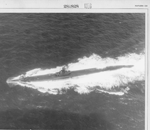 |
978k |
The boat is a Government design 2/1/1 Balao class boat. It is probably one of the earlier Government Balao's, with this picture probably taken sometime in early 1944 or late '43. |
US National Archives photo # 80G-282828 from NARA, College Park, Maryland, courtesy of Sean Hert.
Photo i.d. & text courtesy of David Johnston |
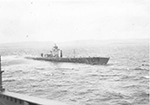 |
1.05k |
Mystery Tambor - probably Tautog (SS-199), Fremantle. |
Photo courtesy of Robert Morgan. |
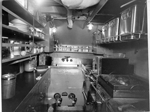 |
500k |
Galley of a US submarine. |
USN photo # 80-G-19400 from NARA, College Park, Maryland, courtesy of Sean Hert. |
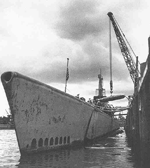 | 181k | An Electric Boat built Gato class with a Mod 4 fairwater loads torpedoes before a WW II patrol. | USN photo courtesy of Scott Koen & ussnewyork.com |
 | 104k | A Mod 3 Balao class EB design. Photo probably taken early 44.
| Photo i.d. courtesy of David Johnston
USN photo # 80-G-468172, courtesy of Scott Koen & ussnewyork.com. |
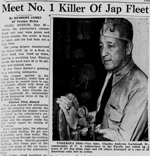
08360lkwd |
NR |
Meet No. 1 Killer Of Jap Fleet
UNDERSEA DOG - Vice Adm. Charles Andrews Lockwood, Jr., commander of U. S. submarines in the Pacific has rolled up a score of 517 Jap ships sunk and 150 others damaged at a cost of 20 American subs lost in action. |
Image and text provided by University of North Carolina at Chapel Hill Library, Chapel Hill, NC.
Photo & text by The Wilmington Morning Star. [volume] (Wilmington, N.C.) 1909-1990, 29 May 1944, FINAL EDITION, Image 3, courtesy of chroniclingamerica.loc.gov.
|

0836044g | 1.06k | Labeled as Gar (SS-206). I can absolutely confirm that the boat in the attached picture IS NOT the Gar. The boat is a Government design Type 1 Balao. The photo was most likely taken in early 1945, and I would guess by the pristine condition of the boat was most likely taken in the Atlantic shortly after commissioning.
I have seen this photo labeled as the Gar before. Most notably it is in Robert C. Stern’s Squadron/Signal Publication’s U.S. Subs in Action from 1979 labeled as Gar and this may be the source of the original confusion. Mr. Stern’s book, while mostly well done and authoritative, contains two glaring errors, this being one of them. I have a copy and refer to it often, but I have learned to be careful with it. | Text i.d. courtesy of David Johnston.
Photograph courtesy of Peter Schupp. |
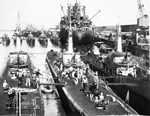 |
319k |
U.S. subs at Fremantle, 1945. |
Photo courtesy of slwa.wa.gov.au (State Library of Western Australia) via Steven Gower. |
 |
894k |
Proteus (AS-19) moored to a buoy, with fleet boats alongside, late wartime, probably 1945 and shows two Balao / Tench class and possibly a Gato class (inboard boat).
| USN photo courtesy of Scott Koen & ussnewyork.com.
Text courtesy of David Johnston. |
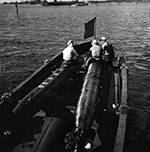 | 531k | Small boat carries torpedoes to a submarine. Photographed by Lieutenant Commander Horace Brisol, TR-15201, May 1945. | USN photograph # 80-G-468352, now in the collections of the National Archives courtesy of the National Museum of the U.S. Navy, via flickr.com. |
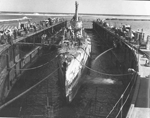 | 1.62k | A Government design Balao/Tench, May 1945. I would place the location at one of the advance island bases, possibly Midway or Saipan. Notice the close location of the surf line behind the drydock. This rules out Pearl Harbor or Guam.
|
Photo & text i.d. courtesy of David Johnston
USN photo # 80-G-468241 courtesy of Scott Koen & ussnewyork.com
|
 |
651k |
Thought to be Barb (SS-220) at Mare Island, probably May 1945.
This photo shows an EB design Gato class submarine. It has a late war Mod 4 fairwater configuration. The Mod 4 has the bridge cut down to expose the covered wagon ribs and the SJ radar mounted forward.
Barb never had this configuration. She finished the war with a Mod 3A which has the bridge at the original height and the SJ mounted aft of the periscopes. Confirmed post war photos also show her in this configuration.
As for the mystery boat, I can not give you an exact ID. I would place the date in mid 1945. |
Photo & text i.d. courtesy of David Johnston
USN photo courtesy of Scott Koen & ussnewyork.com
|
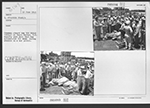 | 1.00k | According to the caption on the photo crewmen aboard the Bream (SS-243) at Pearl Harbor & this ...crewmen touching up rusted areas on the Bream ... has the temporary # 24
Robert Baker writes: This boat is more than likely the Kingfish (SS-234). When I zoom in on the photos of Kingfish on her page and look at the sides of her conning tower especially the area underneath her after AA mount, the little details look identical, including the number of perforations in that little side plate. Kingfish forward AA deck was somewhat square shaped. Although hard to tell, 24's sort of looks that way, too. It's admittedly difficult to tell for sure from the new photo, but it gives me that impression. DANFS shows that she was at Pearl until 17 June, so assuming the date on the photo is correct that would match up.
The identity of these boats is always a challenge for those people who would like to i.d. them (which is what we try to do here). According to Dave Johnson (who has been quite proficent in this area)
The infamous BuAer strikes again. This boat is without a doubt NOT the Bream. Bream was a EB built Gato. The boat with the 11 on the fairwater is a 2/1-1 configured Government built Balao or Tench. I agree with the date of the photo, but the photographer screwed up the ID. I have seen this many times with BuAer photos. That is what you get when you let a bunch of airdales take photos of submarines! ?? Take any ID by BuAer with a grain of salt until it can be verified. Notice the greyhound logo above the 11. This might help in identifying her. Remember that the two digit numbers seen on Pearl Harbor based boats were temporary in nature, used to visually identify the boats to harbor control and to friendly forces while the boat was conducting pre-patrol local workups. They were often reused and thus are of little help in identifying the boat. | Photo i.d. & text courtesy of Robert Baker & Dave Johnson.
Photographs # 80-G-325171, 325180 & 325183 by Photographer's Mate First Class L. Strawger, from NARA, College Park, Maryland, courtesy of Sean Hert. |
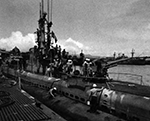
0824327 | 202k | Original Caption: At the Pearl Harbor submarine base, crewmen touch up the rusted areas on Bream (SS-243), which has just completed a successful war patrol, 15 June 1945.
An unknown Type 1A Balao or Tench class submarine undergoing some paint touchups at Pearl Harbor, spring 1945. Note the number 11 on the conning tower fairwater. Unfortunately this number can not be used to identify the submarine, as these numbers were temporary nature, used for identification purposes in Hawaiian waters only while the boat was on a pre-patrol training cruise. They were painted out prior to the boat departing on patrol, and oftentimes were reused. | Photographs # 80-G-325172 & 80-G-325173, by Photographer's Mate First Class L. Strawger, now in the collections of the National Archives, courtesy of National Museum of the U.S. Navy via flickr.com. |
 | 240k | Fleet submarines - Adm Lockwood visit Luzon. | USN photo courtesy of Scott Koen & ussnewyork.com. |
 | 273k | An EB design Balao or Tench She is carrying a mast configuration that is unique to the late war EB design that I call the 1/3 (or "one three"). The SJ radar is situated on a thin mast forward of the periscope shears, and the SD (or later SV) radar is on a thick mast very similar to the periscope shears immediately aft of the shears. The photo clearly shows the bases of this triple mast arrangement. EB and Manitowoc completed 21 boats to this configuration. Those are: SS-337 to 352, SS-375 to 378, and SS-435. I would bet my lunch that the mystery boat is one of these 21. Unfortunately, there isn't enough else in the photo to provide any further identification. If I had an exact date the pic was taken, I could eliminate any of the boats commissioned after that date. So far, we only know that the pic was taken sometime after his commissioning as an officer on 15 June 1945. The actual date of the photo could even be post war.
One long shot for the ID of the boat is Sarda (SS-488). She was the lone oddball of the Government design Tench's in that she also had a 1/3 mast arrangement. Sarda was a test boat for an experimental design for a longer conning tower, and this probably drove the unique mast arrangement on her. | Text i.d. courtesy of David Johnston.
Photo courtesy of LT Howard G. Havens collection at the Vallejo Naval and Historical Museum via Darryl L. Baker. |
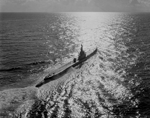 | 690k | Photo dated 22 July 1945. The boat looks like an early Balao class and is probably a Government design, although the pic quality is not good. Hard to tell for sure. I can get nothing else from the photo.
| Photo i.d. courtesy of David Johnston
USN photo # 80-G-335390, courtesy of Scott Koen & ussnewyork.com. |
 | 2.27k | Submarines that are bound for the States, as seen by the Fulton (AS-11) on 18 August 1945.
Capt. E.W. Grenfell, USN, coming aboard unknown submarine. | US National Archives photo # 80-G-337675 by W.T. Henthorne from National Archives and Records Administration (NARA), College Park, Maryland, courtesy of Sean Hert. |
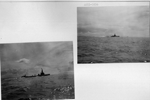 | 9.13k | 4 Photo PDF of submarines bound for the States as seen by the Fulton (AS-11) on 18 August 1945.
The boat is a 2/1-1 configured Government design Balao/Tench. I can't give you much more than that.
| Text i.d. courtesy of David Johnston (USN, retired)
US National Archives photos by W.T. Henthorne # 80-G-337661/63, 66 & 67 from National Archives and Records Administration (NARA), College Park, Maryland, courtesy of Sean Hert. |
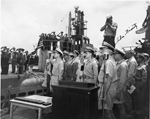 | 305k | Admiral Lewis Parks, behind the woman in the Red Cross Uniform stands at attention as does Admiral Chester Nimitz (name written on picture above his head) and others during an unspecified ceremony. The group of sailors standing on the left are standing on the deck of a submarine. | The photograph is included in Lewis Parks's photo album entitled "Submarine Pictures W. War II."
Photos # 2015-162 (insert) & 2015-163 courtesy of trumanlibrary.org.
|
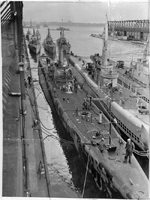 | 409k | East side story: A minyan of subs alongside the pier at Staten Island.
1st row: EB Balao(twin 20mm mount on the forward deck), Government Balao, Government Mod 4 Gato 2nd row: Mod 3 Gato?, Mod 4 Gato, unknown Balao, 3rd row: unknown Balao?, Mod 4 Gato On the other pier to the right: Mod 4 Gato, unknown Balao? Photo date: immediate post war, fall of 1945. | USN photo courtesy of John Hummel, USN (Retired).
Photo i.d. courtesy of David Johnston. |
 | 1.80k | I would not concentrate on this boat being a Tench The late war configuration of both the Balao's and Tench's were nearly identical.
This boat has what I call the 2/1/1 mast configuration. That is the two scopes followed by the thin SJ mast, with the separate air search mast set back on the cigarette deck. The air search radar appears to be the late war big dish SV, but it is hard to tell for sure. It appears she has a 40mm on the forward fairwater gun deck (the pic is really grainy and this is not confirmed), and a 20mm Mk 10 open mount on the aft fairwater gun deck (confirmed).
The configuration of her forward main gun deck is not unusual. It is typical of most of the Government design Balao's of the late war period. The as built configuration for these boats was with the 4"/50 cal Mk 9 gun in the forward position. This gun was quite long and required a big deck to allow the crew to move as it was trained. By late war this gun had been replaced by the stubbier 5"/25, usually in the aft position, which required less deck space.
I believe the two digit number to be a local Hawaii system used to identify the boat to friendly forces during local training exercises during the war, without giving away the boat's ID to any potential lurking Japanese eyes. They were abolished almost immediately upon the cessation of hostilities and replaced with the boat's actual hull number. I have yet to see any documentation to this effect, so this is nothing but an educated guess. With this in mind, and with the original photo information below, I would place the date on the photo right at the end of hostilities, between 28 August and 2 September.
| USN photo courtesy of Fred Lester, ETN3(SS).
Photo i.d. courtesy of & David Johnston. |
 | 433k | West side story: subs alongside the pier at Mare Island.
The photo is a post war view of berths 1-4 at Mare Island. I put the date prior to December 1945 since ARD-11 was to the right of the pier to the right corner of the photo from December 45 to September 46. On 1 September 46 ARD-11 was berthed at the location of the first row of boats until mid 1947. | USN photo courtesy of John Hummel, USN (Retired).
Photo i.d. courtesy of Darryl L. Baker & David Johnston. |
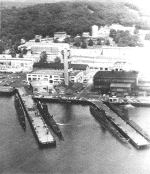 | 271k | A closer view of a few boats alongside at lower base, with landmark escape training tank.
| Submarine Force Library, courtesy of Ken Hart. |
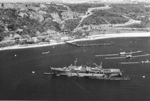 |
401k |
Submarine tender Nereus (AS-17) in a two point moor off Ballast Point at Point Loma, San Diego. Early 1960's. Submarines alongside include the Perch (ASSP-313), which is the outboard boat. The inboard boat is one of the former radar-picket submarines (SSR), Rasher (AGSS-269), Raton (AGSS-270), or Rock (AGSS-274). This picture was taken after Perch lost her cylindrical hangar from the after deck, and after the SSR's lost their radars in the late 1950's. The inboard boat is considerably longer than the Perch, and has an extended sail, both indicators of a former SSR. The radar's proved quite troublesome in service and the concept of the submarine radar-picket died once AEW aircraft on carriers entered service. |
Text courtesy of David Johnston
USN photo courtesy of Scott Koen & ussnewyork.com. |
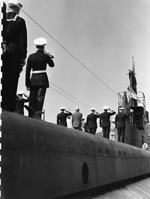 | 305k | Naval and civilian personnel on board a United States submarine participate in what appears to be a flag ceremony. The officers salute as the bugler plays, circa 1946. | The photograph is included in Lewis Parks's photo album entitled "Submarine Pictures for Sub Base New London, CT."
Photo # 2015-196 courtesy of trumanlibrary.org.
|
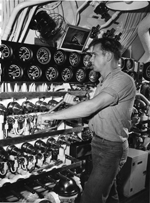 | 473k | A unidentified sailor watches the gauges and instruments while working inside a United States submarine. A "pin-up" photo can be seen above the top row of gauges, circa 1946. | The photograph is included in Lewis Parks's photo album entitled "Submarine Pictures for Sub Base New London, CT."
Photo # 2015-204 courtesy of trumanlibrary.org.
|
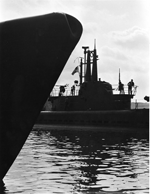 | 271k | Two submarines are docked, probably at New London, Connecticut. The people visible on the far submarine are unidentified, circa 1946. | The photograph is included in Lewis Parks's photo album entitled "Submarine Pictures for Sub Base New London, CT."
Photo # 2015-168 courtesy of trumanlibrary.org.
|
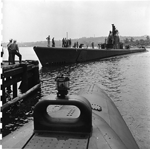 | 289k | A United States submarine enters port, probably New London, Connecticut. The sailors on the dock and on board the deck of the ship are all unidentified, circa 1946. | The photograph is included in Lewis Parks's photo album entitled "Submarine Pictures for Sub Base New London, CT."
Photo # 2015-193 courtesy of trumanlibrary.org.
|
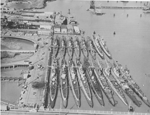 | 289k | Inactivated submarines at Mare Island in early 1946.
Front row left to right: Sand Lance (SS-381), next two could be Sealion (SS-315) and Seahorse (SS-304), Searaven (SS-196), Pampanito (SS-383), Gurnard (SS-254), Mingo (SS-261), Guitarro (SS-363), Bashaw (SS-241).
Back row left to right: Unknown, Tunny (SS-282), next three could be Sargo (SS-188), Spearfish (SS-190), and Saury (SS-189), Macabi (SS-375), Sunfish (SS-281), Guavina (SS-362), Lionfish (SS-298), Piranha (SS-389).
The Scabbardfish (SS-397) is docked in ARD-11 on the other side of the causeway.
Tiru (SS-416) is on the ways in upper left hand side of photo. Two ferry boats (to the right of Tiru's ways) are YHB-2 / [ex-Post of Stockton] and YHB-21 / [ex-Tamalpais]. | Photo i.d. courtesy of Darryl L. Baker.
USN photo courtesy of Scott Koen & ussnewyork.com. |
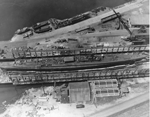 | 536k | The boat sitting on the marine railway at the Submarine Base in New London is indeed a Government design Gato It is a Mod 4A with the lowered bridge and the separate air search radar mast aft of the shears. This dates the photo to late 1944 at the earliest. The problem is that all of the Gato's would have been long gone from New London by this date. The last of the Portsmouth Gato's was Steelhead (SS-280) and she was commissioned in December '42. The Squadron 50 boats were pulled back from Europe in mid-1943 and sent to the Pacific, and at this time they would have been sporting a Mod 3 (with the high bridge, covered wagon ribs not exposed) if they had any fairwater mods at all.
So with all this in mind, this photo could not have been taken even in late 1944. The only time where you would see a Mod 4A Gato in New London would be post war. A lot of Gato's were laid up in reserve there at finger piers on the north side of the base. I am speculating that this photo shows a boat going through a pre-lay up overhaul. Guns have been removed from the fairwater gun decks, work is being done on the aft engine room mufflers, and there is a big tarp over the deck gun. It is hard to tell, but the air search radar looks like a big dish SV. I would place the date sometime in 1946 or early 1947.
The Whale (SS-239) looks the closest, right down to the extra holes drilled in her casing round over - forward, aft, but not midships. | Photo courtesy of Wendy Gulley via Ron Reeves (of blessed memory).
Photo i.d. courtesy of Dave Johnston & Robert Morgan. |
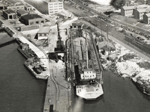 | 1.40k | Sub base New London, CT., Marine Railway aerial 1943 & Waterfront south end aerial 1946. | Photos courtesy of Wendy Gulley via Ron Reeves (of blessed memory). |
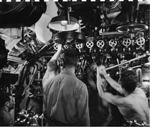 | 375k | Five unidentified sailors are working below deck on a United States Submarine, circa 1946. | Photograph is from an album entitled "Submarine Pictures for Sub Base New London, CT."
Photo # 2015-169 courtesy of trumanlibrary.org.
|
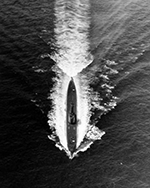 | 300k | U. S. Submarine Training at Key West, 10 December 1948. | Photo # 97-1787 courtesy of trumanlibrary.org.
|
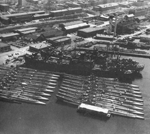 | 826k | Mothballed subs of the New London Group of the Atlantic Reserve Fleet. |
USN photo thanks to Jim Kurrasch @ Battleship Iowa, Pacific Battleship Center.
|
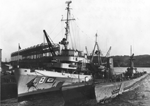 | 905k | Welcome to Berth #1, Yokosuka Naval Base, 31 December 1952.
The Coucal (ASR-8) keeps company with: The inboard boat is a Fleet Snorkel built by Portsmouth or Cramp. It was thought to be the Sabalo (SS-302), but the configuration definitely is one of the FM mine detection sonars, the QLA, an FM sonar for mine detection. It was nicknamed, "Hells Bells"
The outboard boat is a government yard built Balao or Tench.
Robert Morgan wrote: The limber hole pattern is suggestive of a small number of Portsmouth-planned Balao. Just aft of the sea steps or handholds cut into the side of the casing about where the forward gun foundation is, the limber holes "step". They change shape and elevation along the casing. It's hard to know for sure, but boats that had this feature included many of the Cramp-built Balao through about SS-299-ish, then a couple afterwards like Sablefish (SS-303). Cramp did things oddly!
Portsmouth seems to have used this pattern inconsistently as well. Pampanito (SS-383) seems to have had it, as did Pilotfish (SS-386), but a few others in the same hull number bloc do not have it. Plaice (SS-390) did not.
I haven't checked the very late Portsmouth and Mare Island boats, yet. But, we seem to be looking for a postwar mostly unmodified Balao with a semi-rare limber hole pattern that made a trip to Japan.
Dave Johnston wrote: There were three patterns to the Government design limber holes for the Balaos:
1. The original, as designed, as built pattern (Version 1)
2. A modification to Version 1 that consisted of between 18 and 23 enlarged limber holes amidships (Version 2)
3. A pattern of 9 to 11 enlarged limber holes that started just below the forward gun foundation running aft. (Version 3). Some of this version were modifications to Version 1 after launching, and some were an as-built configuration.
Boats of the first production run at Portsmouth (285-291) carried Version 1 throughout their entire service lives and were never modified.
For the Cramp boats, Devilfish (SS-292) carried Version 1 her whole life. Escolar (SS-294) and Lancetfish (SS-296) didn't survive long enough to be modified so they also carried Version 1. The remainder of the Cramp boats (297-303 & 425-426) all were either modified to Version 3 or were built with it.
For the 2nd run of Portsmouth boats, only Sand Lance (SS-381) and Picuda (SS-382) carried Version 1 their whole lives. All of the rest of that run were built with Version 1 but were modified to Version 2 at some point.
The first run of Mare Island boats (304-312) were never modified from their original Version 1. For the 2nd run Spadefish (SS-411) and Trepang (SS-412) were modified to Version 3 after launching, and 413-416 were all built with Version 3.
One oddball was the famous Pampanito. She had one additional row of 13 holes added just aft of the bow planes right along the bottom edge of the superstructure. She was the only boat with this modification (in addition to having a Version 2 added after construction).
All of the Government built Tench class boats were built with Version 3 (except the three that were finished as Guppies).
Hells Bells,etc
To identify these boats, I was keying on the topside sonar arrangement on the forward deck of the Fleet Snorkel. The streamlined dome on the starboard side is either a WFA or BQS-3. That in itself was not unusual. What caught my eye was the can-on-a-post directly to port of this dome. The unconverted boat outboard also has it in the same location. These two boats are the only two I have ever seen with this arrangement. It is not the JT sonar, both boats have the T-shaped JT head just aft of this feature. It has me completely stumped. None of my references mention or identify it, and I have never seen it in any other picture. It might not even be sonar gear. It's possible that it is some other type of topside equipment.
Could this be some kind of antenna, esp. one for direction finding of radio communication or radar signals? I'm thinking this may be a good possibility.
ECM
Typical of the way Howard Lorenzen operated, was the overnight revolution in the way his branch supported the silent service. Starting with the Pike (SS-173) in July 1944, all of NRL's submarine intercept and DF systems had located the intercept antennas on the conning tower, necessitating exposure and attendant risk when collecting signals. In December 1957, Rear Admiral Elton W. Grenfell, a submariner and mechanical engineer, came in from the Pacific Fleet, where he commanded U.S. submarine forces, and complained to Howard Lorenzen that he had written his last memorandum to BUSHIPS. He wanted hardware - now!
Lorenzen summoned several engineers and technicians to a brainstorming session in his office. Submariner Grenfell accepted Ralph A. Carpenter's proposed communications intercept configuration (15 KHz-265 MHz) and Reid Mayo's ELINT amplifier and crystal video detector (2.5-12 GHz), but rejected all of his ELINT antenna offerings as too large and grotesque - which stimulated William Edgar Withrow's design of a double-armed spiral antenna, not much bigger than a silver dollar, to fit inside a periscope.
A month later, following integration and testing at Kolmorgen Optical, Inc. in North Hampton, Massachusetts, Kolmorgen's modified periscope (type 8A) and NRL's intercept equipment were installed on the Dogfish (SS-350) in New London, Connecticut, to support its mid-January deployment to the Barents Sea. Reid Mayo and Ed Withrow observed the installation, tested the ECM system, participated in sea trials, and trained operators. They did the same in February for a second system on the Wahoo (SS-565) in Yokusaka, Japan. Wahoo would operate in the western Pacific. The full-production system (AN/BLR-6) transitioned to industry in June, just six months after Rear Admiral Grenfell pounded the table.
- See more at: A Tribute to the Father of Electronic Warfare & Video newsreel from 1953 about VLF:
Based on the ship's actions, and need to stay submerged nearly all of the time while conducting patrol activities (as confirmed in patrol reports), any gear mounted like the mystery gear would have been useless if it was an RF antenna (with the exception of VLF **). It would seem very unlikely that this apparatus was for any radio purpose. The declassified patrol reports for Sabalo (SS-302) make no mention of any special ECM equipment except for one exception - The AN/FRR-23 (seems to have been specially installed) was employed during a 26 day patrol in February - March 57 for communications monitoring in the HF range (2-32MHz) and an antenna would have to be out of the water and wouldn't seemingly be a special, mission specific antenna for HF.
**It is very interesting to note that in a declass/prior top secret addendum to the patrol rpt of Mar-February '57 it mentioned that the FRR-23 was utilized for the daily reception of the YS (Yankee Sierra) broadcasts with success. And:
"It is recommended that the feasibility of interim application of this equipment to this task be considered to assure receipt of YS broadcasts in remote areas until more reliable coverage is provided by new VLF stations."
However upon researching what VLF antennas may have looked like on early submarines I found this picture; nothing like the mystery gear - which still remains so, but I conclude it is not a radio antenna.
|
Photo # 80-G-476570 from NARA, College Park, Maryland, courtesy of Sean Hert.
Text courtesy of Robert Morgan & David Johnston & Jeff Owens, webmaster and historian for Sabalo (SS-302), Larry Douglas, Howard Venezia, & Vic Peters for input. |
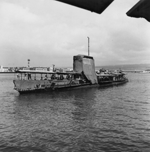 | 182k | Formerly thought as Carp (SS-338) undergoing a change of life.
This photo, as evidenced by the arrangement of the limber holes in the superstructure is clearly a government design boat, probably built at either Portsmouth NSYD or Mare Island. | Text i.d. via Robert Porterfield.
Photo courtesy of Ron Phillipi.
|
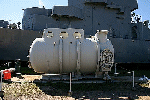 | 42k | The pressure hull of the conning tower of the Carp (SS-338).
The conning tower shown is that of a Gato-class boat. The clue here are the two water tight doors shown, one on the starboard side of the conning tower and the other in its after bulkhead. This arrangement is typical of Gato-class submarines. These doors were found to be a liability to safe operation of the boat early in WWII and were not used on Balao-class boats, of which Carp was one. Even some of the later Gatos had this type of conning tower removed and replaced by Balao-class towers. You will notice in photos of Carp's port side prior to its conversion to a fleet snorkel submarine in the fifties, that there is a doorway forward on the conning tower fairwater. This was for quick access to the deck from the control room by the gun crews and were served by a gun access trunk located just forward of the conning tower. Boats with water tight doors in the conning tower had doorways near the after end of the fairwater, aft of the conning tower.
I served aboard Carp and qualified in submarines aboard her. Further, I spent many hours on watch in the conning tower at sea as helmsman and know there were no water tight doors installed. Time spent chipping and painting inside the superstructure made me quite familiar with the arrangement of the conning tower. | Text i.d. via Robert Porterfield.
Photo courtesy of Len Mozey via Hal Taft. |
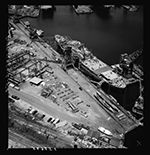 |
3.00k |
4 photo PDF alongside the Observation Island AG-154) at Norfolk Naval Shipyard, circa late 1950's.
It shows two strange submarines sitting on a pier at Norfolk Naval Shipyard in the late 1950's. I recall discussing this set of photos a while back. I was under the impression that it was decided that they were construction mockups or trainers of some sort. I can tell you with an extremely high degree of confidence that neither "submarine" shown is a combat submarine of the U.S. Navy.
Both boats are simply too small. Take a look at the cars on the pier and compare the size to the size of the boats and you will see just how small they are. For further reference several of the shots show Sailors in the background and using them for a reference it becomes pretty apparent that they wouldn't even be able to stand upright if they were inside these boats.
Also, the configuration of the hull and superstructure on the boats does not match any known submarine class.
The other issue is how did they build them in this spot, and once completed how did they intend to get them into the water? There are no building ways for them to slide down and even though they are small boats they most likely would have been too heavy to lift (when completed) using the available cranes.
So what are these things? My first thought was that they were some sort of construction pathfinders or mockups. However, I was recently reading in a magazine article about nuclear testing in the Marshall Islands and there was a mention of a sub-scale "submarine simulator" being used to gauge the effects of an underwater burst on a submarine's hull and internal systems. I immediately thought of these two mystery boats. I did some digging and found out that unfortunately they were not the simulators used in the nuclear tests, but could they have been built as targets for more conventional depth charge or torpedo testing? It is known that there was an underwater explosive shock laboratory in Norfolk and these two subscale boats may have been built as targets so that a full scale operational boat did not have to be risked. I am having a hard time thinking of any other valid use for these two small boats.
By the way, the purpose built submarine targets used in the Operation Wigwam nuclear tests were called "Squaws" and were built at the Long Beach Naval Shipyard. I found references to three of them being built, but there may have been more.
|
Photos courtesy of NARA, National Archives Identifier: 6929052, Local Identifier: 19-NN-AG-154 Observation Island, From: Series: Photographs of U.S. and Foreign Naval Vessels, 1883 - 1972, Record Group 19: Records of the Bureau of Ships, 1940 - 1966, courtesy of Stephen Gower.
Photo i.d. courtesy of Jim Christley, Ric Hedman, David Johnston (USN, retired) Robert Morgan & Ron Reeves (of blessed memory). |
 | 889k | Trident boat underway in the blue Pacific. | Photo i.d. courtesy of Terry Byrd.
USN photo courtesy of Scott Koen & ussnewyork.com. |
 | 303k | Port bow view of a Trident boat. | Photo i.d. courtesy of Terry Byrd.
USN photo courtesy of Scott Koen & ussnewyork.com. |
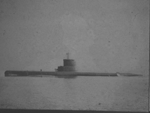 |
441k |
This is a negative from The U.S. Naval Training Device Center (Recognition Training). |
Photo courtesy of Tommy Trampp. |
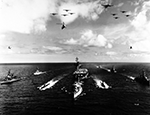 |
527k |
Task Group ALFA, formation portrait of the anti-submarine group's ships and aircraft, taken during 1959 exercises in the Atlantic, while Secretary of the Navy William B. Franke was embarked. Ships include the group flagship, Valley Forge (CVS-45) in center, two submarines, and seven destroyers. Identifiable among the latter are Eaton
(DDE-510) at left front, Beale
(DDE-471) following Eaton, Waller
(DDE-466) in the center foreground, and Conway
(DDE-507) at right front. Aircraft overhead include two formations of S2F Trackers from the
Valley Forge air group, plus one shore-based P2V Neptune from Norfolk Naval Air
Station, Virginia. Two HSS-1 helicopters are flying low, directly over the submarines. |
Official USN photograph # USN 1043095 courtesy of the National Museum of the U.S. Navy, via flickr.com. |
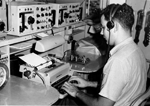 |
291k |
Submarine radioman 1960's, boat unknown.
|
Photo courtesy John Hummel. (USN, retired).
|
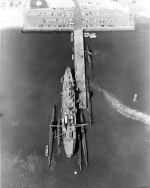 | 153k | Subs alongside of the Sperry (AS-12). There are three Guppies, one AGSS, and Skipjack class 585's. The Caiman (SS-323) looks like the boat overhanging the end of the pier. Caiman was a Guppy 1A and had the sail, bow and aft messenger buoy on the port side as shown.
| USN photo courtesy of ussubvetsofworldwarii.org.
Text courtesy of David Johnston. |
 | 256k | Photo from the Evans (DE-1023) in the Sea of Japan in April-May 1967. We were doing ASW drills with two subs (showing the flag in the area). The boat is a Guppy II or IIA, possibly the Menhaden (SS-377) or Razorback (SS-394).
|
USN photo courtesy of Darryl L. Baker.
Photo i.d. courtesy of David Decrevel, John Hart, Ric Hedman, John Hummel, & David Johnston. |
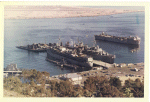 | 360k | US Naval Submarine Base, Point Loma. It is circa 1968. Identifiable bow on is the submarine tender Nereus (AS-17). Inboard of her is the submarine tender Sperry (AS-12), with the 2nd boat outboard of her is the Bream (SS-243) with a 594 Permit class nuke.
In the left foreground is the Menhaden (SS-377). All of the submarines in the photo have had some type of "Guppy" conversion. | USN photo courtesy of Robert M. Cieri.
Text i.d. courtesy of David Johnston. |
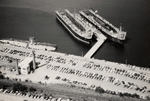 | 2.09k | Subase Groton, CT.: The photo shows Grouper (AGSS-214) alongside an unidentified Government design Balao/Tench, with a Permit class boat in the drydock. I would guess the date to be approximately 1968. It looks like Grouper is going through the decommissioning process so that give us a rough date. |
Photo & text i.d. courtesy of David Johnston
USN photo # NPC K-85366 courtesy of Scott Koen & ussnewyork.com
|
 | 51k | Tinosa (SSN-606) underway with her crew on deck saluting the 'Stone Frigate' HMS Dolphin October 1970.
Note; Not the 606, she was in Portsmouth Naval Shipyard from May 1969 until December 1971 for a sub-safe overhaul.
| Photo from Conway's All The World's Fighting Ships, 1947-1995 & submitted by Robert Hurst.
|
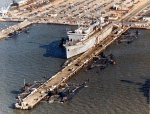 | 94k | Subs alongside of the L.Y. Spear (AS-30); Photo was probably taken late 70's or early 80's in what looks like Norfolk. There are eight Sturgeon (SSN-637's) and one Los Angeles (SSN-688) in port.
| USN photo courtesy of ussubvetsofworldwarii.org.
Text courtesy of David Johnston. |
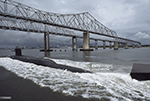 | 636k | Leaving home port, a nuclear submarine heads down the Cooper River. | Photo by Annie Griffiths Belt/National Geographic/Getty Images, courtesy of gettyimages.com.
|
 | 606k | Lots of water and little space surround a 637 class underway. | USN photo # N-0000X-115 courtesy of extensis.cnrc.navy.mil. & Bob Shouse. |
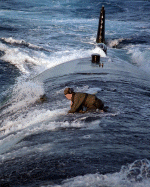 | 495k | Tail end Charlie on the back of a 637 class underway. | USN photo # N-0000X-109 courtesy of extensis.cnrc.navy.mil. & Bob Shouse. |
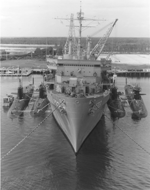 | 330k | Subs alongside of the Simon Lake (AS-33); three Benjamin Franklin class (SSBN-640) and a Lafayette class (SSBN-616) alongside in Kings Bay, GA. The photo's time frame is probably around 1979-80 right after Kings Bay opened because the pier parking lot (light color patch on aft port side) is unpaved. | USN photo courtesy of ussubvetsofworldwarii.org.
Text courtesy of David Johnston (USN, retired) & Jim Harper. |
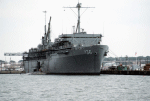 |
179k |
A starboard bow view of the submarine tender L. Y. Spear (AS-36) moored at the destroyer and submarine piers at Norfolk Naval Base on 7 September 1983. A Sturgeon class nuclear-powered attack submarine pumped way up in the bows is moored alongside.
|
Photo i.d. courtesy of John Hummel & Jim Christley.
Official USN photo # DN-ST-85-11655, by Don S. Montgomery, from the Department of Defense Still Media Collection, courtesy of dodmedia.osd.mil. |
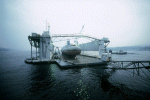 | 123k | A Boomer rests inside the large auxiliary floating dry dock Los Alamos (AFDB-7) shortly before being lowered into the water at Navy Fleet Ballistic Submarine Refit Site 1 on 1 December 1985. | USN photo # DN-ST-87-02364, by JOC Fred J. Klinkenberger, from the Department of Defense Still Media Collection, courtesy of dodmedia.osd.mil. & submitted by Bill Gonyo. |
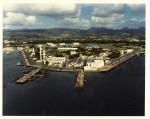 | 409k | US Naval Submarine Base, Pearl Harbor. It is circa 1987. | USN photo courtesy of Robert M. Cieri. |
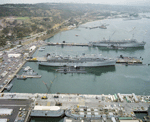 |
1.50k |
Dixon (AS-37) & McKee (AS-41) with unknowns, April 1987. |
USN photo # DN-SC-88-05861 courtesy of Scott Koen & ussnewyork.com. |
 | 186k | The large harbor tug Mister Don from Corpus Christi maneuvers a fast attack submarine out of the harbor at Point Loma, 1 February 1988.
| USN photo # DN-SN-88-06097, by PHC David Fraker, from the Department of Defense Still Media Collection, courtesy of dodmedia.osd.mil. & submitted by Bill Gonyo. |
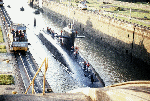 | 227k | Crewmen stand on the deck of a U.S. Navy Lafayette Class nuclear-powered ballistic missile submarine as it passes through the Miraflores Locks of the Panama Canal circa 1 September 1989. Following behind the submarine are two U.S. Navy PBR Mark 2 river patrol boats. | USN photo # DA-ST-90-07099, from the Department of Defense Still Media Collection, courtesy of dodmedia.osd.mil. & submitted by Bill Gonyo. |
 | 503k | A port bow view of the nuclear-powered attack submarine Ray (SSN-653) underway near Naval Station, Norfolk, Virginia on 1 February 1991.
Though claimed to be of Ray off Norfolk in '91, this picture could not have been taken after her 1983 overhaul - her Towed Array fairing was installed during her 83-85 overhaul, and is clearly not visible in the picture under detailed photo analysis by myself and other photo analysis experts. The topside safety track clearly is just below the sail, water running through it. The TA fairing should be visible just 1 - 2 feet below it, but water is clearly just running down a Also, several other artifacts in the picture suggest that the picture has been altered in Photo-shop, especially the final number and other topside configurations of the boat not germane to Ray. I was also the boat's Deck LPO for a year - I knew every inch of topside of Ray, being responsible for keeping it maintained. Also, as historian and PAO, I had all known photos of Ray in the ship's official records in my keeping taken prior to my arrival in '81, and subsequent photos I was responsible for scheduling and arranging until I left. This picture was never in the ship's official records. Crew members aboard at the time after I left until her decommissioning also confirm this isn't Ray. A check with a former crew mate who is currently involved in the Towed Array program in Bremerton confirmed to me that the TA fairings are not removed until they arrive for the recycling program. There are other inconsistencies in the picture that are contrary too. | Official USN photo # DN-ST-91-05698 by PH1 C.A. Komperda, from the Department of Defense Still Media Collection, courtesy of dodmedia.osd.mil & submitted by Bill Gonyo.
Photo i.d. courtesy of John R.V. Jones, STS1/SS, USS RAY (SSN-653) '81 - '86 COMSUBRON 4 Staff '86-'88. |
 | 174k | An aerial view, looking west, of a section of the naval base showing two of the destroyer and submarine (D&S) piers located on the south end of the installation. A submarine tender and several nuclear-powered attack submarines are tied up, 22 January 1995.
The submarine in the right hand corner is most likely the Narwhal (SSN-671). She has a general 637 hull and sail structure but the hull is longer. Her fat line array stowage tube is on the starboard side versus the port as on a 637. While the 685 was also a stretched 637 hull, her fat line tube was still on the port side; only Narwhal and the 688's have it on the stbd side. It also appears this was during the period when she had the thin line array "hump" on her stern.
| USN photo # DN-ST-95-01441, by Robert J. Sitar, from the Department of Defense Still Media Collection, courtesy of dodmedia.osd.mil.
Photo i.d. courtesy of Phil Tuckey. |
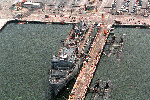 | 183 | An aerial view of a section of the Naval Station showing destroyer and submarine (D&S) pier #22 with the submarine tender L.Y. Spear (AS-36) tied up on the north side of the pier. On the south side of the pier is three Sturgeon class and one Los Angeles class nuclear-powered attack submarines, 25 June 1995. | USN photo # DN-SC-95-02164, by Robert J. Sitar, from the Department of Defense Still Media Collection, courtesy of dodmedia.osd.mil. |
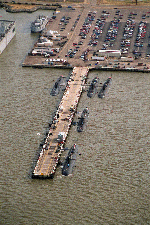 | 346k | Five Los Angeles class nuclear-powered attack submarines are tied up at destroyer and submarine (D&S) pier 22 at the naval base. NAS, Norfolk, VA, 28 January 1996.
| USN photo # DN-SC-97-00620, by Robert J. Sitar, from the Department of Defense Still Media Collection, courtesy of dodmedia.osd.mil. |
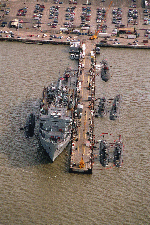 | 316k | A bow-on view of the submarine tender L.Y. Spear (AS-36) tied up at destroyer and submarine (D&S) pier 21 with four Los Angeles class and three Sturgeon class nuclear-powered attack submarines are tied up at destroyer and submarine (D&S)pier 22 at the naval base.
NAS, Norfolk, VA, 28 January 1996. The first sub across the pier from the L.Y. Spear's stern is the Finback (SSN-670).
| USN photo # DN-SC-97-00621, by Robert J. Sitar, from the Department of Defense Still Media Collection, courtesy of dodmedia.osd.mil. |
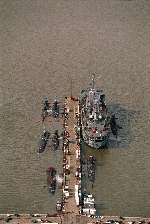 | 736k | A stern view of the submarine tender L.Y. Spear (AS-36) tied up at destroyer and submarine (D&S) pier 21 at the naval base. Moored with the L.Y. Spear is four Los Angeles class and three Sturgeon class nuclear-powered attack submarines are tied up at destroyer and submarine (D&S)pier 22 at NAS, Norfolk, VA, 28 January 1996. The first sub across the pier from the L.Y. Spear's stern is the Finback (SSN-670).
| USN photo # DN-SC-97-00623, by Robert J. Sitar, from the Department of Defense Still Media Collection, courtesy of dodmedia.osd.mil. |
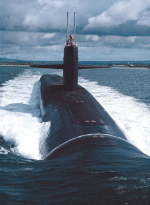 | 133k | A Ohio class submarine heads out to sea from the submarine base at Pearl Harbor, Hawaii, 23 September 1997. | USN photo # N-0000U-019, & submitted by Bill Gonyo.
Photo i.d. courtesy of Darryl L. Baker, John Hummel, Bob Shouse & David Johnston. |
 |
1.10k |
Here is an undated photo that I found in the files of the Vallejo museum. I have not been able to determine which submarine this is by reviewing shipyard records or the yard's newspapers.
Here are my observations and conclusions:
The boat is departing Mare Island. She is passing the old NAD at the south end of the yard.
The boat in question is a short hull 637 Class
The tug alongside is the Dekuary (YTM 178) – She was at the yard from 1950 until she was decommissioned in October 1985.
Boat has a towed array (TB-16 or 23) – I do believe all 637 Class boats had towed arrays by 1980/81.
Boat has a new paint job and therefore was in dry dock at the yard.
Based on the Dekuary's decommissioning date and the towed array (assumption) the photo was therefore taken between 1981 and 1985.
I reviewed the yard's repair records for this period and developed a list of possible boats.
Pogy (SSN-647)
637 - Short
Overhaul 1980-81 and several SRAs until 1984,
Ocean Engineering Boat
Drum (SSN-677)
637 - Short
SRA 1980
Gurnard (SSN-662)
637 - Short
SRA 1980
Tautog (SSN-639)
637 - Short
Overhaul 1979
Parche (SSN-683)
637 - Long
Too many to list,
Ocean Engineering Boat
R. B. Russell (SSN-687)
637 – Long
Too many to list,
Ocean Engineering Boat
|
Photo from the files of the Vallejo Naval and Historical Museum via Darryl L. Baker. |
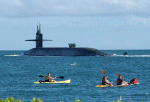 | 185k | An american submarine (Trident) leaving Pearl Harbor for commencement in Exercise RIMPAC 2004 The naval assets for RIMPAC 2004 included four U.S. Pacific Fleet nuclear-powered attack submarines, Key West (SSN-722), Louisville (SSN-724), Charlotte (SSN-766), and Olympia (SSN-717).
There are forward 5-inch countermeasures and no rear 6-inch countermeasures. If my knowledge is correct, the west coast boats had been converted to 6-inch prior to 2004 (or at least for the most part) which means that this picture is most likely of a prior east coast boat.......being either the Pennsylvania (SSBN-735) or the Kentucky (SSN-737). Also, the location of the aft draft reading typical of the east coast boats, the west coast ones usually have theirs a little more forward.
| Photo # 000-169-804_0155, courtesy of defence.gov.au/rimpac04.
Text i.d. courtesy of Johns. |
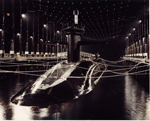 | 310k | A unknown Ohio class passing through the Magnetic Silencing Facility at Bangor, WA. The only possible i.d. would be this serial number. | USN photo courtesy of Jim Geldert. |
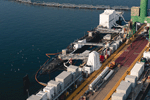
0836044w | 1.95k | Aerial photograph of a 688 at Newport News Shipbuilding, September 2021.
Filling in the blanks. | Photo # 4-8-DCS21-302-375-2 by Ashley Cowan, courtesy of nns.huntingtoningalls.com
|




































































































































